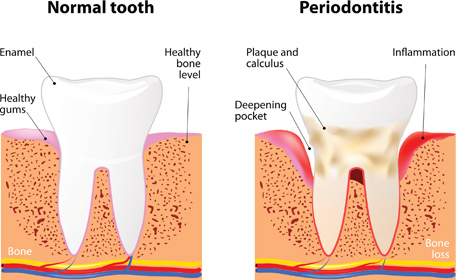Periodontal Disease

Gum disease, sometimes called periodontal disease, is one of the leading causes of tooth loss. The bacteria that cause this dental disease have been lined to serious health problems such as heart problems, poor circulation leading to diabetic concerns, strokes premature and even low birth rate babies and even cancer. When we treat gum disease, our concern is for your overall health, not just your teeth. Even with all the advancement in prevention, 70% of all adults still have some form of gum disease present in their mouth. For this reason we always do a thorough evaluation so we can prescribe the right level of cleaning.
Actually there are 3 different levels of gum and bone disease. Even in 2012 approximately 75% of the adult population still has some form of gum disease. Given all the advances in our service and technology this isn’t a particular proud number for our profession since it hasn’t significantly changed in the last several decades. If your one of the 25% - congratulations! A preventive (or regular) level of cleaning works well for you if you have no evidence of disease in your mouth. For the other 75% there are several options of therapeutic cleaning and treatment you need to know about.
If you have disease present, which means bleeding, tenderness or increased depth of the cuff of tissue around your teeth, then a therapeutic cleaning is what is needed for you. Depending on your individualized problem you may benefit from either Supportive Periodontal Therapy (SPT), Scaling or Root Planing, or LANAP (laser treatment to address gingival pocketing and bone loss).
Supportive Periodontal Therapy is a more thorough cleaning regimen designed to remove excess deposits that are inflaming the gum tissue.
Scaling and Root Planing is an even more thorough cleaning removing deposits and toxic substances that have attached to the roots of the teeth. Typically there is loss of the supportive bone because of these elements.
Often, these two therapeutic regimens are combined, again depending on the amount and location of disease present.
In summary always remember there are levels and unless you’re one of the fortunate 25% these other levels should be part of your conversation with your dentist and hygienist. Call us if you would like to learn more; and remember, “it’s not just a cleaning.”
Modern Gum Disease Treatment Using LANAP
The Laser Assisted New Attachment Procedure (LANAP®) is a form of laser gum disease surgery that does not harm healthy tissue. Traditional gum disease surgery uses a scalpel to cut away both healthy and unhealthy tissue, LANAP® uses a different approach, more specifically, a laser to remove only the diseased portions. This minimally invasive procedure results in less pain and less bleeding than traditional gum disease surgery. LANAP® gum disease surgery is widely regarded as the highest standard of care available for gum disease treatment, not to mention that patients rarely require pain medication following the procedure. Dr. Rachel Brinker is a periodontist in Mill Valley, California who provides patients with laser gum disease surgery.
Thanks to the advent of the PerioLase® MVP-7™, the LANAP® trained periodontist, Dr. Brinker can remove and kill bacteria without harming the healthy gum tissue. This is because the PerioLase® MVP-7™ is a highly intelligent laser that can easily distinguish between healthy and diseased gum tissue, based on the color and tint. In fact, LANAP® is the only method of laser gum disease surgery that has been cleared by the FDA. It is also the only form of laser gum disease surgery with the science and research to prove its effectiveness.
Periodontal disease is an epidemic that affects millions of Americans each year, yet very few actually seek treatment. This is largely because they do not understand the risk of complications that can arise. If left untreated, gum disease can lead to an increased risk in heart disease, diabetes, and pancreatic cancer. Until now, the only options for gum disease surgery involved the painful cutting and stitching of tissue. With LANAP®, this is no longer true.